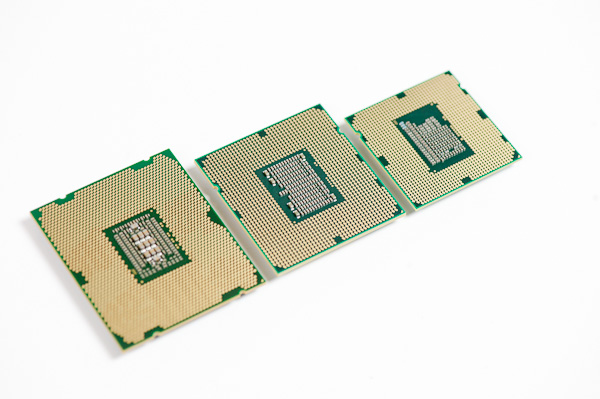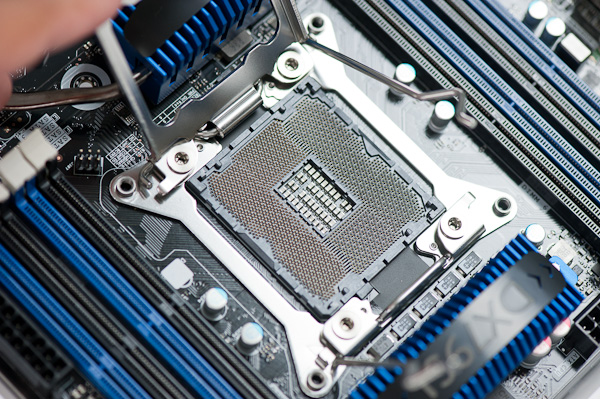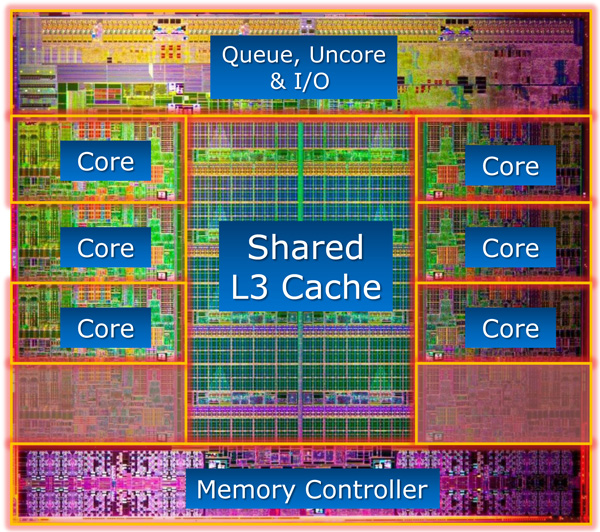Intel Core i7 3960X (Sandy Bridge E) Review: Keeping the High End Alive
by Anand Lal Shimpi on November 14, 2011 3:01 AM EST- Posted in
- CPUs
- Intel
- Core i7
- Sandy Bridge
- Sandy Bridge E
If you look carefully enough, you may notice that things are changing. It first became apparent shortly after the release of Nehalem. Intel bifurcated the performance desktop space by embracing a two-socket strategy, something we'd never seen from Intel and only once from AMD in the early Athlon 64 days (Socket-940 and Socket-754).
LGA-1366 came first, but by the time LGA-1156 arrived a year later it no longer made sense to recommend Intel's high-end Nehalem platform. Lynnfield was nearly as fast and the entire platform was more affordable.
When Sandy Bridge launched earlier this year, all we got was the mainstream desktop version. No one complained because it was fast enough, but we all knew an ultra high-end desktop part was in the works. A true successor to Nehalem's LGA-1366 platform for those who waited all this time.

Left to right: Sandy Bridge E, Gulftown, Sandy Bridge
After some delays, Sandy Bridge E is finally here. The platform is actually pretty simple to talk about. There's a new socket: LGA-2011, a new chipset Intel's X79 and of course the Sandy Bridge E CPU itself. We'll start at the CPU.
For the desktop, Sandy Bridge E is only available in 6-core configurations at launch. Early next year we'll see a quad-core version. I mention the desktop qualification because Sandy Bridge E is really a die harvested Sandy Bridge EP, Intel's next generation Xeon part:
If you look carefully at the die shot above, you'll notice that there are actually eight Sandy Bridge cores. The Xeon version will have all eight enabled, but the last two are fused off for SNB-E. The 32nm die is absolutely gigantic by desktop standards, measuring 20.8 mm x 20.9 mm (~435mm^2) Sandy Bridge E is bigger than most GPUs. It also has a ridiculous number of transistors: 2.27 billion.
Around a quarter of the die is dedicated just to the chip's massive L3 cache. Each cache slice has increased in size compared to Sandy Bridge. Instead of 2MB, Sandy Bridge E boasts 2.5MB cache slices. In its Xeon configuration that works out to 20MB of L3 cache, but for desktops it's only 15MB. That's just 1MB shy of how much system memory my old upgraded 386-SX/20 had.
| CPU Specification Comparison | ||||||||
| CPU | Manufacturing Process | Cores | Transistor Count | Die Size | ||||
| AMD Bulldozer 8C | 32nm | 8 | 1.2B* | 315mm2 | ||||
| AMD Thuban 6C | 45nm | 6 | 904M | 346mm2 | ||||
| AMD Deneb 4C | 45nm | 4 | 758M | 258mm2 | ||||
| Intel Gulftown 6C | 32nm | 6 | 1.17B | 240mm2 | ||||
| Intel Sandy Bridge E (6C) | 32nm | 6 | 2.27B | 435mm2 | ||||
| Intel Nehalem/Bloomfield 4C | 45nm | 4 | 731M | 263mm2 | ||||
| Intel Sandy Bridge 4C | 32nm | 4 | 995M | 216mm2 | ||||
| Intel Lynnfield 4C | 45nm | 4 | 774M | 296mm2 | ||||
| Intel Clarkdale 2C | 32nm | 2 | 384M | 81mm2 | ||||
| Intel Sandy Bridge 2C (GT1) | 32nm | 2 | 504M | 131mm2 | ||||
| Intel Sandy Bridge 2C (GT2) | 32nm | 2 | 624M | 149mm2 | ||||
Update: AMD originally told us Bulldozer was a 2B transistor chip. It has since told us that the 8C Bulldozer is actually 1.2B transistors. The die size is still accurate at 315mm2.
At the core level, Sandy Bridge E is no different than Sandy Bridge. It doesn't clock any higher, L1/L2 caches remain unchanged and per-core performance is identical to what Intel launched earlier this year.
The Lineup
| Processor | Core Clock | Cores / Threads | L3 Cache | Max Turbo | Max Overclock Multiplier | TDP | Price |
| Intel Core i7 3960X | 3.3GHz | 6 / 12 | 15MB | 3.9GHz | 57x | 130W | $990 |
| Intel Core i7 3930K | 3.2GHz | 6 / 12 | 12MB | 3.8GHz | 57x | 130W | $555 |
| Intel Core i7 3820 | 3.6GHz | 4 / 8 | 10MB | 3.9GHz | 43x | 130W | TBD |
| Intel Core i7 2700K | 3.5GHz | 4 / 8 | 8MB | 3.9GHz | 57x | 95W | $332 |
| Intel Core i7 2600K | 3.4GHz | 4 / 8 | 8MB | 3.8GHz | 57x | 95W | $317 |
| Intel Core i7 2600 | 3.4GHz | 4 / 8 | 8MB | 3.8GHz | 42x | 95W | $294 |
| Intel Core i5 2500K | 3.3GHz | 4 / 4 | 6MB | 3.7GHz | 57x | 95W | $216 |
| Intel Core i5 2500 | 3.3GHz | 4 / 4 | 6MB | 3.7GHz | 41x | 95W | $205 |
Those of you buying today only have two options: the Core i7-3960X and the Core i7-3930K. Both have six fully unlocked cores, but the 3960X gives you a 15MB L3 cache vs. 12MB with the 3930K. You pay handsomely for that extra 3MB of L3. The 3960X goes for $990 in 1K unit quantities, while the 3930K sells for $555.
The 3960X has the same 3.9GHz max turbo frequency as the Core i7 2700K, that's with 1 - 2 cores active. With 5 - 6 cores active the max turbo drops to a respectable 3.6GHz. Unlike the old days of many vs. few core CPUs, there are no tradeoffs for performance when you buy a SNB-E. Thanks to power gating and turbo, you get pretty much the fastest possible clock speeds regardless of workload.
Early next year we'll see a Core i7 3820, priced around $300, with only 4 cores and a 10MB L3. The 3820 will only be partially unlocked (max OC multiplier = 4 bins above max turbo).


















163 Comments
View All Comments
Valitri - Wednesday, November 16, 2011 - link
Good review as always.Turns out to be slightly less than I was expecting. The performance "jump" from an 1155 SB just isn't there for generic enthusiasts and gamers. Perhaps encoders, renderers, and mathmaticians will enjoy the performance but it doesn't do much for me. Makes me very happy I stepped to a 2500k and I look forward to Ivy Bridge early next year.
Gonemad - Wednesday, November 16, 2011 - link
If there are 16GB DIMMs, and this sucker has 8 DIMMs sockets... 128GB in a home system... hmmm. It makes SSDs all the less appealing. (Specially because you just blew lots of money in DIMM memory, but still...). Pop in a Ramdrive, wait 5 minutes to boot... don't wait anymore. I can see some specific usage that could benefit of this kind of storage subsystem speed. Even if it is a 'tiny' 64GB ramdrive.It may not entirely replace a small SSD, but you can do some neat tricks with that kind of RAM at home. I know only one module is many times more expensive than a SSD, but just the fact that you can do it is remarkable.
Too bad this chip costs a lot, and IT. IS. HUGE. The thing has the size of a cup-holder, or at least the socket. With that amount of die you could build 2 * i7- 2600k and with the amount of money you blow on one, you can still pay for 3 * i7s.
Oh yes, check for yourselves. That's your premium profit margin right there.
This sucker has 435mm2 while the Sandy Bridge 4c has 216mm2. Twice more!
This behemoth will nick your pockets in $999, when a i7-2600k cuts you $317.
Nearly 3 times more. More than 3 times in fact. It is almost pi() times more. Wait, it is pi times more expensive, up to the third decimal. Hmm. I bet you are paying for the lost wafer too. Or it is just a wild coincidence. It doesn't perform twice as better, only 50% better, in some benchies. And it is so big that you can almost call it a TILE, not a CHIP. I am betting that on the same die you build 3 * 2600k, you can build only 2 of these and lose the difference. It should squash the competition. It is a bomb.
Some chip.
Diminishing returns indeed.
Wolfpup - Wednesday, November 16, 2011 - link
"All of this growth in die area comes at the expense of one of Sandy Bridge's greatest assets: its integrated graphics core"Whaaaaat? Greatest assets? It's a waste of space. It should be used for more cache or another core or whatever on the quad version. I can't believe this site...Anandtech of all places...has ANYTHING positive to say about integrated graphics!~
noeldillabough - Wednesday, November 16, 2011 - link
For laptops the integrated graphics is AWESOME however on my gaming machine with top end graphics cards eating space for integrated graphics seems silly.jmelgaard - Thursday, November 17, 2011 - link
The fact that you still talk about X number of cores shows you haven't understood my posts.Your thinking: "How many cores can I make my game utilize"
My model: "How many small enough jobs of processing can I split my game up into"
Number of cores have no relevance in modern architectures, while in a Game engine you properly wan't to take control over the execution of those jobs, priority jobs etc.
The funny thing is, your BF3 already runs on 500+ cores when it comes to the rendering, lighting, polygon transformations and so on... All by chopping the big job of rendering a screen into little bits of work... just like i suggest you can do with the rest of a game, just like we do with so many other applications today.
"I doubt it. There's a reason why game engines are modified as they get older."
Almost every single corp only sees ahead to the next budget year...
seapeople - Saturday, November 19, 2011 - link
Of course it's inevitable you would resort to personal attacks and profanity in an argument you are losing.It's a different mindset... do you think graphics work is programmed by thinking "Ok, today's GPU's have 500 cores, so let's optimize our game to use exactly 500 threads..."
abhicherath - Sunday, November 20, 2011 - link
Why?Why are those 2 fused off....seriously for a 1000 buck CPU, you don't expect intel to hold stuff back....gosh, this is competition crap. If AMD's bulldozers were powerful as hell and outperformed the i7's i sure as hell expect that those 2 cores would be active....what's your opinion?
jmelgaard - Sunday, November 20, 2011 - link
"This doesn't involve a diatribe about number of cores in modern architectures."What what?... Do you even know what you are writing anymore?
What I am talking about is software architecture, which is highly relevant to the discussion.
Flerp - Sunday, November 20, 2011 - link
Even though there are very healthy gains in specific areas, I find the Sandy E to be a bit underwhelming, especially compared to how badly the X58 slaughtered the 775 platforms when it made its debut. I guess I'll be holding on to my X58 platform for another year or so and see what kind of improvements Ivy will bring.jmelgaard - Monday, November 21, 2011 - link
@rarsonThe whole reason I begin to talk about software architectures is because you are so hell-bend on sticking to your idea of "optimizing to a number of cores", I had to have you realize that you need to let go of that idea, your refusal to do so only makes me hope that you don't actually work with software development. No offence intended, because I would never be fit building a house either, it's not my field.
If you had ever gotten to understand that, the next discussion would be if it was beneficial to adopt this strategy within games, if it was viable and if it had a ROI that was worth pursuing if you could choose outside the bounds of this years budget, would it be an architecture that might cost us 2 to 3 times to pursue now, but saved us 20% development costs on our next games or engines for the next 10 years.
Of-course this could be a swing-and-miss if someone revolutionized how we look at our processors, much like they have done with GPU's, but as we have "barely" entered the multi-core-cpu-era, I don't expect this to happen within the next 10 years.
However that is all irrelevant because 10 years is not the time-frame, it is not even 5 or 3... the time-frame is a year at a time, and the cheapest solution in the time-frame of this years budget, that's the chosen one, that's the reason you are looking for, that is why they do it. And this is how almost, if not all, stock-based corporation operates. Why?... Because they have to satisfy stockholders... There is no other reason or rationalizations behind it.
DICE it self is not a stock-based company, but it is a fully owned by Electronic Arts, which is. And so EA's financial numbers is directly impacted by DICE as it counts towards EA's assets (not necessarily Revenue though).
With that, I am done with you, your best argument seems to be "They did it, so that must be the right thing to do"... When was anyone's choice ever evidence of it being the best one?